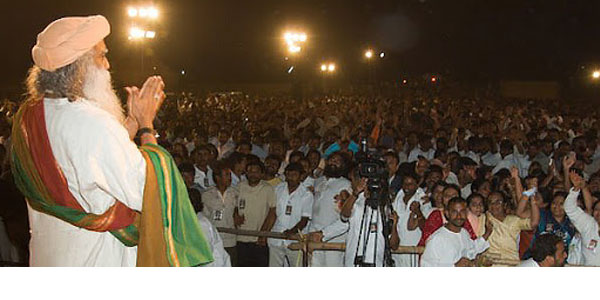Cauvery Calling – A Model for the Tropical World

“This is not about me or the government – this is a generational work.” —Sadhguru
Sadhguru: In Kannada language, the word “varsha” means rain. It also means “year” and also “land”, as in “Bharat Varsh”. There is only one word for all of them because the whole civilization revolved around the monsoon.
We must understand, the monsoon is the only source of water in this country. In the last hundred years, there has not been a big change in the volume of water that is coming down in the form of monsoon rains on the subcontinent. However, earlier, the spread used to be between 120 to 150 days. Now the spread is somewhere between 40 to 75 days, which means the same volume of water is coming in a more concentrated amount of time. Because of this, there is a cycle of flood and drought happening across the country.
We are still treating floods and droughts as two different problems. These are not two different issues, this is just one problem – we are not able to hold the water that comes down in the form of monsoon rains. There is a certain communication between tree cover and clouds, which we have destroyed. Because of this, rain is coming in a more concentrated timespan, causing floods and droughts.
If there is a flood, there is bound to be a drought because water that should have percolated into the earth is unfortunately running on the surface. This is what we are trying to change. The only solution for this is to bring back tree cover.
There is no question right now of increasing forest cover largescale, because the population pressure is huge. If we want to bring back tree cover, the only way to do it is through agroforestry. Agroforestry is the practice of planting trees alongside conventional crops.
In the last 18 years, we have brought 69,760 farmers into agroforestry. We have found that their incomes have gone up 300 to 800 percent in five to seven years – and it continues to grow. So making timber into agricultural produce is very lucrative for the farmer.
One aspect is that in the first four years, the farmer needs some financial support while making the shift. As a part of this, we requested both the Karnataka and Tamil Nadu governments to give an incentive for four years to help the farmer make the shift. Fortunately, both governments have agreed in principle to provide this incentive.
For the last few months, our volunteers have been travelling to villages across the Cauvery basin educating the farmers about agroforestry. 2.7 lakh farmers in Cauvery basin have expressed the intention that they would like to convert to agroforestry. Both the governments are definitely giving subsidies to the farmer for this.
Cauvery Calling: A Model for the World
The idea of Cauvery Calling is to create a demonstrable model and make it a living example for everyone else. If we successfully implement this, this is not about Cauvery alone, this will be a game-changer for India and the whole tropical world.
The farmers are willing and the two state governments want to give subsidies to help the farmers to shift, so these two things are in place. The third aspect is the larger society, which is you and me, especially the urban population. Even a beggar in Mumbai can plant one tree a month for 42 rupees.
If a beggar can plant one tree, how much should you do? This should be the question mark in your head. This is not about me or the government – this is a generational work. Fundamentally what we have to look at is, are we a responsible or irresponsible generation? This will be proven by how we act in the next few years.


